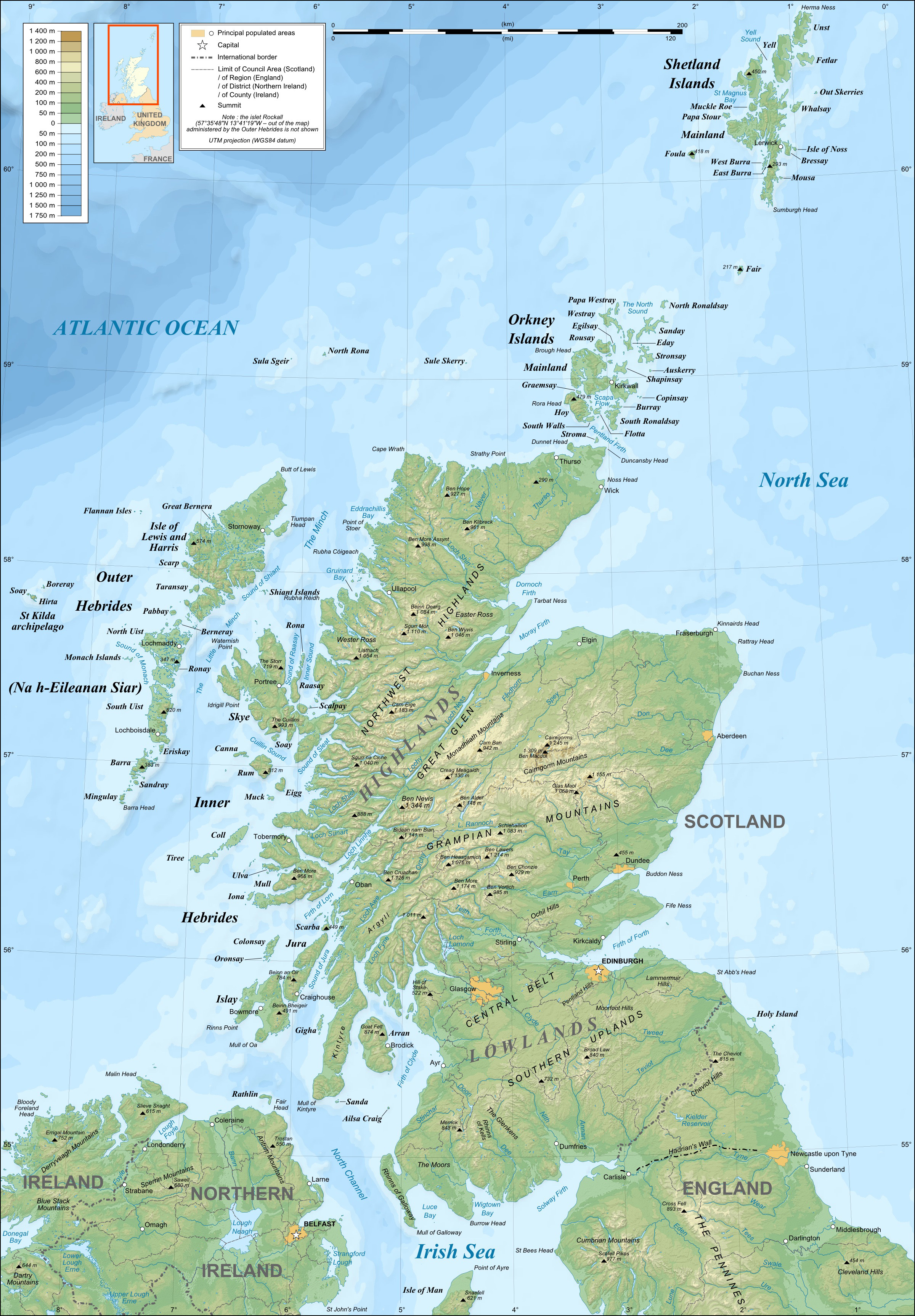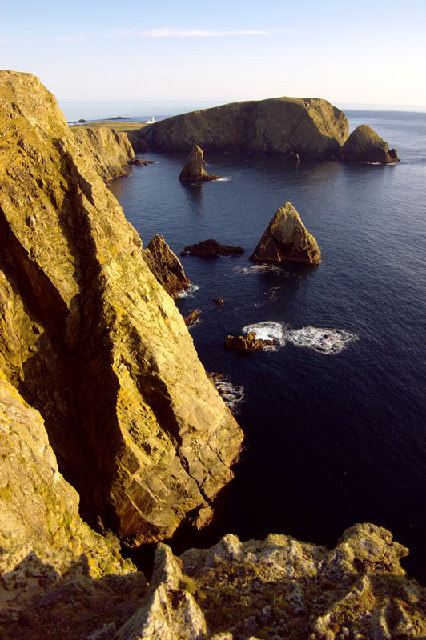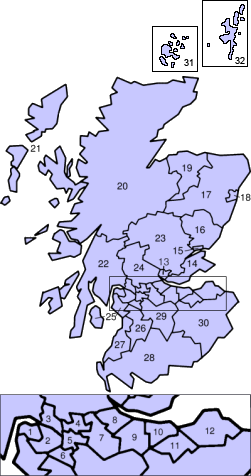|
Northern Isles
The Northern Isles ( sco, Northren Isles; gd, Na h-Eileanan a Tuath; non, Norðreyjar; nrn, Nordøjar) are a pair of archipelagos off the north coast of mainland Scotland, comprising Orkney and Shetland. They are part of Scotland, as are the Hebrides. The climate is cool and temperate and much influenced by the surrounding seas. There are a total of 36 inhabited islands. The landscapes of the fertile agricultural islands of Orkney contrast with the more rugged Shetland islands to the north, where the economy is more dependent on fishing and on the oil wealth of the surrounding seas. Both island groups have a developing renewable energy industry. Both have a Picts, Pictish and Norse activity in the British Isles, Norse history. Both were part of the Norway, Kingdom of Norway until they were absorbed into the Kingdom of Scotland in the 15th century. They remained part of it until the 1707 formation of the Kingdom of Great Britain and the 1801 formation of the United Kingdom. ... [...More Info...] [...Related Items...] OR: [Wikipedia] [Google] [Baidu] |
Ward Hill, Hoy
Ward Hill is a hill on the island of Hoy in Orkney, Scotland. It lies at the north of the island between Moaness and Rackwick, and is the highest point in both Orkney and the Northern Isles, Scottish Northern Isles at an elevation of . The hill forms a curved ridge, reminiscent of a 'J' in shape. The lower slopes are covered in Calluna, heather and grass, though the top of the ridge is covered in small stones with bare sandy soil. The highest summit is towards the northern end and is crowned by a trig point. The ridge is well separated from the other hills of Hoy, and both the other Marilyn (hill), Marilyns on the island have high topographic prominence. Ward Hill is separated from Cuilags by the Glens of Kinnaird, and from Knap of Trowieglen by the glen carrying the road between Moaness and Rackwick, in which lies the Dwarfie Stane. Ward Hill may be climbed from a variety of starting points. The northern side, directly above Hoy Village is steep and cliff, craggy, and thus presen ... [...More Info...] [...Related Items...] OR: [Wikipedia] [Google] [Baidu] |
Celt
The Celts (, see pronunciation for different usages) or Celtic peoples () are. "CELTS location: Greater Europe time period: Second millennium B.C.E. to present ancestry: Celtic a collection of Indo-European peoples. "The Celts, an ancient Indo-European people, reached the apogee of their influence and territorial expansion during the 4th century bc, extending across the length of Europe from Britain to Asia Minor."; . " e Celts, were Indo-Europeans, a fact that explains a certain compatibility between Celtic, Roman, and Germanic mythology."; . "The Celts and Germans were two Indo-European groups whose civilizations had some common characteristics."; . "Celts and Germans were of course derived from the same Indo-European stock."; . "Celt, also spelled Kelt, Latin Celta, plural Celtae, a member of an early Indo-European people who from the 2nd millennium bce to the 1st century bce spread over much of Europe."; in Europe and Anatolia, identified by their use of Celtic languages ... [...More Info...] [...Related Items...] OR: [Wikipedia] [Google] [Baidu] |
Mainland, Orkney
The Mainland, also known as Hrossey and Pomona, is the main island of Orkney, Scotland. Both of Orkney's burghs, Kirkwall and Stromness, lie on the island, which is also the heart of Orkney's ferry and air connections. Seventy-five per cent of Orkney's population live on the island, which is more densely populated than the other islands of the archipelago. The lengthy history of the island's occupation has provided numerous important archaeological sites and the sandstone bedrock provides a platform for fertile farmland. There is an abundance of wildlife, especially seabirds. Etymology The name Mainland is a corruption of the Old Norse . Formerly the island was also known as meaning 'horse island'. The island is sometimes referred to as '' Pomona'' (or ''Pomonia''), a name that stems from a 16th-century mis-translation by George Buchanan.Buchanan, George (1582''Rerum Scoticarum Historia: The First Book''The University of California, Irvine. Revised 8 March 2003. Retrieved 4 Octo ... [...More Info...] [...Related Items...] OR: [Wikipedia] [Google] [Baidu] |
Pentland Firth
The Pentland Firth ( gd, An Caol Arcach, meaning the Orcadian Strait) is a strait which separates the Orkney Islands from Caithness in the north of Scotland. Despite the name, it is not a firth. Etymology The name is presumed to be a corruption of the Old Norse "Petlandsfjörð", meaning "the fjord of Pictland", and is completely unrelated to the Pentland Hills near Edinburgh. Prior to the Norse occupation of Orkney the strait was known as the "Sea of Orcs" – a reference to the Pictish tribe who inhabited Orkney. Such was their marine prowess that there are also instances of this name referring to the sea lanes of the entire west coast of Scotland down to Kintyre. One version of the 9th-century ''Historia Brittonum'' states that "the Britons originally filled the whole island with their peoples from the English Channel to the Sea of Orcs". Geography On the Caithness (southern) side the Firth extends from Dunnet Head in the west to Duncansby Head in the east, while on the ... [...More Info...] [...Related Items...] OR: [Wikipedia] [Google] [Baidu] |
List Of Outlying Islands Of Scotland
The outlying islands of Scotland are not part of the larger archipelagos and island groups of Scotland—the Hebrides, the Northern Isles or the Islands of the Forth and Clyde estuaries. None of these islands are currently inhabited and few of them ever were, although Hirta was occupied from the Neolithic age until 1930 and Stroma was permanently occupied until the 1970s and thereafter by lighthouse keepers and their families until 1996. Several other outlying islands have lighthouses, none of which is still staffed. In this list, an island is defined as "land that is surrounded by seawater on a daily basis, but not necessarily at all stages of the tide, excluding human devices such as bridges and causeways". A complication relating to membership of this list is that there are various descriptions of the scope of the Hebrides, the large group of islands that lie off Scotland's west coast. The ''Collins Encyclopedia of Scotland'' describes the Inner Hebrides as lying "east ... [...More Info...] [...Related Items...] OR: [Wikipedia] [Google] [Baidu] |
Sule Stack
Sule Stack or Stack Skerry is an extremely remote island or stack in the North Atlantic off the north coast of Scotland. It is formed of Lewisian gneiss. Sule Stack lies north of the Scottish mainland, and west of the Orkney mainland, at . Sule Stack's sole neighbour, Sule Skerry, lies northeast and the remote islands of Rona and Sula Sgeir lie further to the west. Sule Stack and Sule Skerry are home to thousands of gannets and as a result are listed as a special protection area; the island falls within the administrative region of the Orkney Islands. Bird species nesting on the stack include: *Razorbill ''Alca torda'' * Atlantic puffin ''Fratercula arctica'' *Fulmar ''Fulmarus glacialis'' *Great black-backed gull ''Larus marinus'' * Common shag '' Phalacrocorax aristotelis'' * Black-legged kittiwake ''Rissa tridactyla'' * Arctic tern ''Sterna paradisaea'' *Northern gannet ''Morus bassanus'' *Common guil ... [...More Info...] [...Related Items...] OR: [Wikipedia] [Google] [Baidu] |
Sule Skerry
Sule Skerry is a remote skerry in the North Atlantic off the north coast of Scotland. Geography Sule Skerry lies west of the Orkney Mainland at . Sule Skerry's sole neighbour, Sule Stack, lies to the southwest; the remote islands of Rona and Sula Sgeir lie approximately further west. Sule Skerry and Sule Stack are both a part of the Orkney Islands council area. Sule Skerry is in area and about long. It reaches a height of . Pub. 141, Scotland. It is formed of |
Foula
Foula (; sco, also Foola; nrn, Fuglø), located in the Shetland archipelago of Scotland, is one of the United Kingdom’s most remote permanently inhabited islands. Owned since the turn of the 20th century by the Holbourn family, the island was the location for the film '' The Edge of the World'' (1937). The liner RMS ''Oceanic'' was wrecked on the nearby Shaalds of Foula in 1914. Toponym The name "Foula" derives from Old Norse ''Fugley'', "bird island": compare the Faroese name of the island of Fugloy, "bird island", and Scottish Gaelic ''Fughlaigh''. Geography Foula lies in the Atlantic Ocean, west of Walls in Shetland. It was part of Walls civil parish. The island is about , with a low-lying coastal strip along the east side. With an area of , it is the seventh largest and most westerly of the Shetland Islands. It rises from low broken cliffs in the east to precipitous cliffs in the west. The island has five peaks, rising to at the Sneug and at the Kame. At the nort ... [...More Info...] [...Related Items...] OR: [Wikipedia] [Google] [Baidu] |
Fair Isle
Fair Isle (; sco, Fair Isle; non, Friðarey; gd, Fara) is an island in Shetland, in northern Scotland. It lies about halfway between mainland Shetland and Orkney. It is known for its bird observatory and a traditional style of knitting. The island has been owned by the National Trust for Scotland since 1954. Geography the most remote inhabited island in the United Kingdom. It is administratively part of the parish of Dunrossness, Shetland, and is roughly equidistant from Sumburgh Head, some to the northeast on the Mainland of Shetland and North Ronaldsay, Orkney, some to the southwest. Fair Isle is long and wide. It has an area of , making it the tenth-largest of the Shetland Islands. It gives its name to one of the British Sea Areas. Most of the islanders live in the crofts on the southern half of the island, the northern half consisting of rocky moorland. The western coast consists of cliffs of up to in height, Ward Hill at being the highest point of the isla ... [...More Info...] [...Related Items...] OR: [Wikipedia] [Google] [Baidu] |
Council Areas Of Scotland
For local government purposes, Scotland is divided into 32 areas designated as "council areas" ( gd, comhairlean), which are all governed by single-tier authorities designated as "councils". They have the option under the Local Government (Gaelic Names) (Scotland) Act 1997 of being known (but not re-designated) as a "''comhairle''" when opting for a Gaelic name; only ''Comhairle nan Eilean Siar'' (Council of the Western Isles) has chosen this option, whereas the Highland Council (''Comhairle na Gàidhealtachd'') has adopted its Gaelic form alongside its English equivalent informally. The council areas have been in existence since 1 April 1996, under the provisions of the Local Government etc. (Scotland) Act 1994. Historically, Scotland was divided into 34 counties or shires. Although these no longer have any administrative function, they are still used to some extent in Scotland for cultural and geographical purposes, and some of the current council areas are named after the ... [...More Info...] [...Related Items...] OR: [Wikipedia] [Google] [Baidu] |
Highland (council Area)
Highland ( gd, A' Ghàidhealtachd, ; sco, Hieland) is a council area in the Scottish Highlands and is the largest local government area in the United Kingdom. It was the 7th most populous council area in Scotland at the 2011 census. It shares borders with the council areas of Aberdeenshire, Argyll and Bute, Moray and Perth and Kinross. Their councils, and those of Angus and Stirling, also have areas of the Scottish Highlands within their administrative boundaries. The Highland area covers most of the mainland and inner-Hebridean parts of the historic counties of Inverness-shire and Ross and Cromarty, all of Caithness, Nairnshire and Sutherland and small parts of Argyll and Moray. Despite its name, the area does not cover the entire Scottish Highlands. Name Unlike the other council areas of Scotland, the name ''Highland'' is often not used as a proper noun. The council's website only sometimes refers to the area as being ''Highland'', and other times as being '' ... [...More Info...] [...Related Items...] OR: [Wikipedia] [Google] [Baidu] |
Local Government In Scotland
Local government in Scotland comprises thirty-two local authorities, commonly referred to as councils. Each council provides public services, including education, social care, waste management, libraries and planning. Councils receive the majority of their funding from the Scottish Government, but operate independently and are accountable to their local electorates. Councils raise additional income via the Council Tax, a locally variable domestic property tax, and Business rates, a non-domestic property tax. Councils are made up of councillors who are directly elected by the residents of the area they represent. Each council area is divided into a number of wards, and three or four councillors are elected for each ward. There are currently 1,227 elected councillors in Scotland. Local elections are normally held every five years and use the single transferable vote electoral system. The most recent election was the 2022 Scottish local elections and the next election will be ... [...More Info...] [...Related Items...] OR: [Wikipedia] [Google] [Baidu] |






